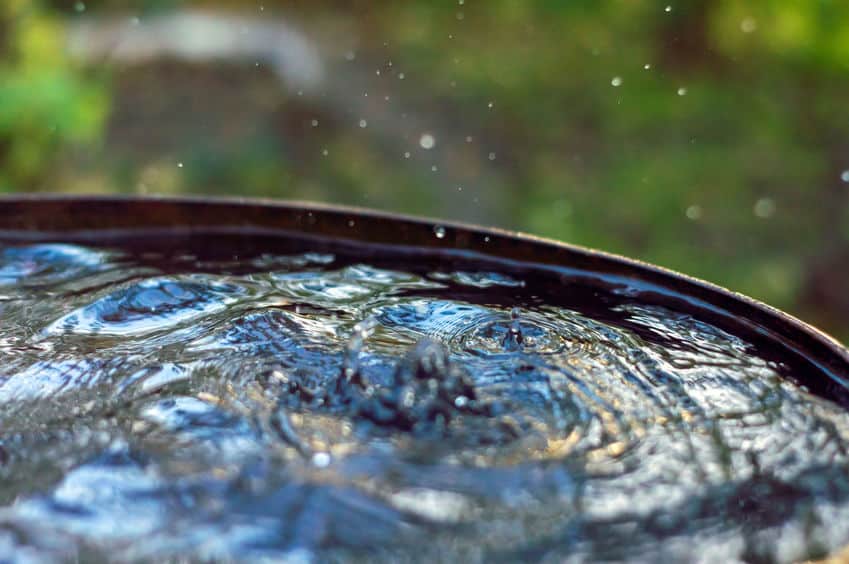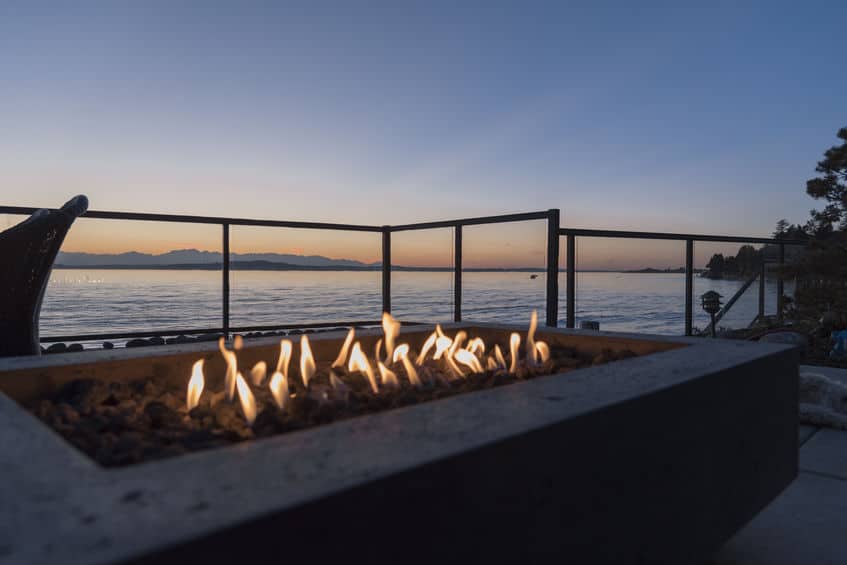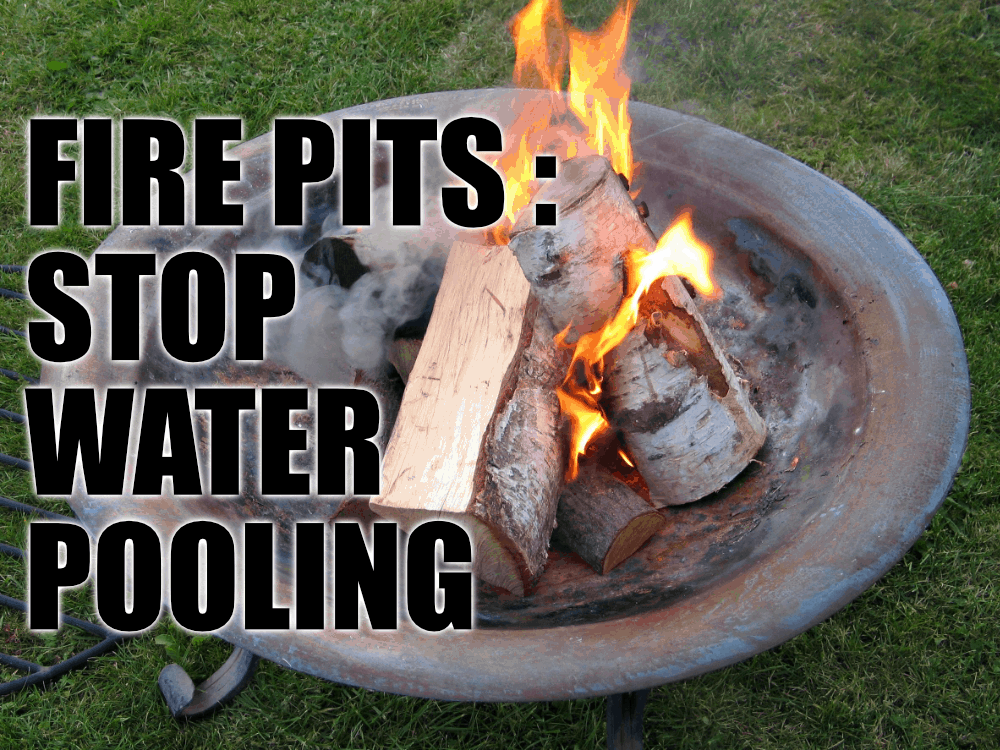Pools of water in a fire pit not only look like a sludgy mess but also render fire ignition extremely tough.
You may even find your pit giving off extra smoke afterwards.
Here’s the bullet points on how to keep water from pooling in your fire pit.
- Decide the Place and Orientation Carefully
- A channel can be Dug
- A Properly Covered Area for Storage
- Using Tarps
- Choosing a Fire Pit with the Right Body Material
- Is it Really Designed to be Used in the Open
In this article we will be dealing with this issue of water pooling and the ways to fix.
Why Does Water Pool in the Fire Pit?
Fire pits are usually designed to be used outdoors. Some may be permanently installed in an outdoor landscape like a garden, while others may be portable and easy to store after a fire. These permanent fire pits are more prone to water pooling.
If no preventive measures are taken, water may gather in your fire pit in large quantities after a heavy rain. Small rain showers for long durations or a snowfall may result in water pools too.
Do Water Pools Affect the Fire Pit?

The fire pits which are designed to be installed in the open permanently, are constructed to deal with the forces of nature.
They can hence endure most weather conditions without getting damaged. A small amount of water may therefore have no impact on your pit.
However, a fire pit may suffer severe rusting if it comes in contact with water excessively and is not protected or cleaned properly later on. It hence be deduced that pools of water in a fire pit do cause adverse effects.
As robust as it might be, without proper care your fire pit becomes more prone to rust and breakdown.
Are Some Fire Pit Designs More Prone to Pooling?
Considering the design of a fire pit is crucial if worried about water retention issues. Some fire pits are installed permanently in the outdoors while some are portable.
Permanently installed fire pits are usually those constructed inside the ground while portable fire pits mainly include metal fire bowls.
- Portable fire pits can be placed under a shed or a covered area after use. This may assure protection of the pit. Furthermore, these pits are easy to rotate over and clean. You may turn your pit over completely, or side-ways if it’s heavy, and remove water from it immediately after a rainstorm.
- Permanently fixed fire pits may experience stagnant water issues more than ever. Since they cannot be turned over to remove water, or cannot be moved to a shaded place, water would remain in there until cleaned properly.
Different Types of Fire Pits May Have Dissimilar Pooling Consequences

We may classify fire pits into two different types: Propane/ Gas Fire Pits and Wood Fire Pits. Each of these suffer different consequences upon encountering the water retention problem.
- Gas fire Pits:
In these, the excessive amount of moisture may cause the gas burner in the pit to malfunction. Water may enter and clog the holes in the burner, acting as a barrier to the gas outlet.
The burner will not ignite easily in such a case. Even if you succeed to light it, a constant popping sound would keep disturbing you. This is a sign that the burner is not utilizing its optimum outlet capacity.
Moreover, these pits mostly have metallic bodies, which are highly susceptible to rust. Though stainless-steel bodies may not rust over time, other metals and alloys show a great deal of damage through rust.
A rusted fire pit won’t last long because it makes the body of fire pit fragile, while also damaging the aesthetics of the pit.
- Wood Fire Pits:
Wood fire pits do not have burners for ignition. Instead, wooden logs have to be chopped and placed inside these. Therefore, water may not affect the pit directly.
However, the wet base of the pit makes it awfully difficult to light a fire. Moreover, the fire produced would give off billows of smoke, making your guests feel irritated.
Simple Steps You Should Take for Good Drainage
There may be several ways of handling this water pooling issue. We have come up with a few simple ones to make the protection of your fire pit easier for you.
Let’s have a look at each one in detail so you can decide what would work best for your pit.
1. Decide the Place and Orientation Carefully:
When designing a permanent fire pit in the open, the most important thing to consider is the ideal placement. An outdoor fire pit should be constructed in a slightly elevated area.
This will help create a steep slope and water would be naturally drained downwards, preventing a lot of water collecting into the pit.
On the other hand, a fire pit constructed in a deep, lowland area would enhance the water pooling problem.
Similarly, an area exposed to sunlight is better to construct a fire pit than a shade. Not only does this work for permanent fire pits, but a portable fire pit may also be moved to a sunny area.
The direct sun exposure will cause water to evaporate, leaving a cleaner and dried out pit.
2. A channel can be Dug:
If you are the owner of a permanent fire pit installed at your place and water retention has become a problem, try digging a channel or ditch besides it.
Most of the time, even a small channel may eradicate your water pooling problem completely. This channel would direct the water away from the pit and the pit will not receive any water at all, staying dry at all times.
This method, however, works best for stationary fire pits as a channel can be dug around them. This is not applicable to the portable fire pits and fire bowls.
3. A Properly Covered Area for Storage
If you have your portable fire pit under a covered patio, your pit is safe! But if you don’t have one, still do not freak out. You can store your pit anywhere, whether it be a shed, a garage or a safe basement.
All you need to remember is the fact that a pit can only be moved once it’s sufficiently cool. So do not try moving it immediately after a fire or you would end up severely burnt and injured.
This, however, is not possible for a stationary pit and you would eventually surrender to a separate cover- a tarp for example.
4. Using Tarps:
This is simply a way of covering the pit when not in use. Being one of the cheapest and most handy solutions, a tarp can be used in both permanent and portable fire pits.
All you need to do is to cover your pit with a strong synthetically made tarp which repels water, keeping your pit moisture free.
Water collected on top of the tarp nonetheless is a common sight. But this is nothing to worry about as the tarp has retained all the water above, and everything below is free of mess and mud.
Tarp is not only a preventive measure against rain and snow, but a perfect shield against insects, and bugs, and the harsh winds and heat as well.
Tarps, however, have to be used carefully with a fire pit. Since these are polymeric materials, they cannot withstand high temperatures. Hence, covering a fire pit immediately after a fire would burn the tarp as well.
It may even result in pungent fumes causing inhaling problems for anyone around.
Make sure your fire pit has been completely cooled off and there is no smoldering coal left behind, as even slight heat would melt the tarp and it won’t be effective in controlling water anymore.
5. Choosing a Fire Pit with the Right Body Material:
Fire pits are prone to come across natural elements like snow and rain despite all the care. It is therefore advisable to choose the fire pit body very carefully. Try going with a stainless-steel body as it will never rust.
Alloy bodies, however, strong they might seem, are not so resistant to corrosion and rust as stainless-steel body is, lasting for a shorter time span.
Yet do not forget that body material just prevents rust and cannot make the burner at the bottom waterproof. Another water prevention measure would still be required.
6. Is it Really Designed to be Used in the Open?
If you are keeping a fire pit outdoors, make sure it is designed to be kept outdoors and is not a pit unable to withstand varying environmental conditions.
Drilling holes in the bottom for Drainage

If none of the above methods work, drilling holes in your fire pit can be an effective way of controlling water retention. These drainage holes may be made in the bottom part of the basin. To properly avoid water pooling, holes of 3/8” in diameter may work effectively.
Not only will these provide a way of water drainage, but would also increase oxygen supply to the flames, increasing the fire pit’s efficiency.
But, if not cleaned after a fire, the collected ash in the pit would block these holes and may not allow proper drainage.
Drilling holes is possible only in portable fire pits and metal fire bowls. The stationary, permanent fire pits made of bricks and rocks cannot be drilled to create drainage.
Depending on the type of fire pit and the availability of resources, several methods can help protect your fire pit and make it last longer.
Alright, that’s it for this article guys, if you found it useful then a share on social media or your website would be cool!
All the best
Steve
ps here’s a few articles related to this one you might find interesting:

